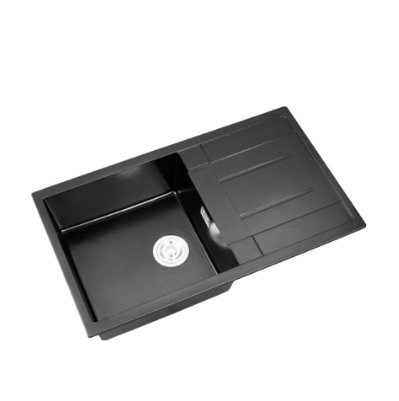Technological Advancements in Granite Sink Production
AI and Automation in Quarrying Processes
The integration of AI and automation into the quarrying processes marks a significant shift towards enhanced efficiency and productivity in granite sink production. AI algorithms play a critical role by predicting and optimizing operations, which substantially boosts yield while minimizing waste. For instance, companies leveraging AI have reported significant reductions in extraction costs and operational downtime. Automation further enhances these benefits with innovations like robotic arms and automated guided vehicles, which are increasingly employed in the extraction and transportation tasks. These technologies not only streamline operations but also ensure safer working conditions by reducing the need for human intervention in hazardous environments.
3D Modeling for Precision Design
Advanced 3D modeling software is revolutionizing precision design in the production of granite sinks. This technology allows designers to create highly detailed and accurate models, which facilitates better visualization and customization options for clients. Several industry leaders have implemented 3D modeling to minimize design errors and accelerate project timelines, as evidenced by case studies that demonstrate reductions in prototyping phases by up to 40%. This capability to offer tailored solutions meets the growing demand for personalized Products, thus enhancing the market appeal of granite sinks and providing a competitive edge.
Waterjet Cutting and Sustainable Manufacturing
Waterjet cutting technology is setting new standards for efficiency and sustainability in granite sink manufacturing. This technique offers precise cutting capabilities, significantly reducing material waste and energy consumption compared to traditional methods. Studies have shown that waterjet cutting can lower emissions by approximately 30%, aligning with the industry's commitment to eco-friendly practices. Moreover, endorsements from industry experts highlight the sustainability benefits, noting how this method supports goals of reducing environmental impact while maintaining product quality. As a result, waterjet cutting not only enhances production efficiency but also positions manufacturers as leaders in sustainable practices within the natural stone industry.
Sustainability and Global Environmental Impact
Eco-Friendly Stone Extraction Practices
Eco-friendly stone extraction practices are revolutionizing the quarrying industry, significantly reducing its environmental footprint. Techniques such as using eco-friendly explosives and minimizing water consumption ensure that granite sinks are manufactured sustainably. A notable example is the use of biodegradable materials in explosives, which drastically reduces the release of harmful substances into the surroundings. Numerous organizations and advocacy groups push for the widespread adoption of these sustainable practices, which are often validated through certifications like ISO 14001. Implementing these methods has shown measurable results, such as a marked reduction in land degradation and positive impacts on biodiversity, such as increased local flora and fauna resilience.
Recycling Initiatives in Granite Sink Manufacturing
Innovative recycling initiatives in granite sink manufacturing are a significant leap toward reducing industrial waste. By incorporating recycled granite into production, manufacturers create products that are not only environmentally friendly but also contribute to a circular economy. Leading brands have already successfully implemented such recycling strategies, impacting the granite supply chain by ensuring that less waste ends up in landfills. For instance, a few manufacturers have developed processes that reintroduce up to 30% of waste material back into production. Studies have shown that such recycling efforts within the industry lead to a substantial decrease in carbon emissions and resource depletion, highlighting the importance of sustainable practices.
Reducing Carbon Footprint Through Innovation
Reducing the carbon footprint in granite sink production is achievable through innovative technologies and practices. By incorporating energy-efficient machinery and leveraging renewable energy sources such as solar or wind power, manufacturers can significantly lower their environmental impact. As outlined in several industry reports, these innovations not only contribute to sustainability goals but also lead to cost savings and enhanced productivity. For example, the deployment of machinery that uses 30% less energy than traditional models has proven highly effective in cutting down emissions. As the industry continues to evolve, adopting these advancements is crucial for meeting future sustainability benchmarks and maintaining the global appeal of granite sinks.
Market Expansion and Regional Economic Influence
Growth in Asia-Pacific Construction Sectors
The burgeoning construction industry across the Asia-Pacific region has significantly impacted the demand for granite sinks. In countries like China and India, where urbanization rates have been notably high, the construction sector's growth is a driving force. For instance, China's construction industry is projected to grow at a compound annual growth rate (CAGR) of over 5% from 2024 to 2028, as reported by industry analysts. This expansion presents great investment opportunities for granite sink manufacturers looking to capture a slice of this booming market. However, challenges such as navigating varying regulatory landscapes and managing supply chain complexities must also be addressed for sustained growth in this region.
North America's Demand for Premium Fixtures
In North America, consumer preferences increasingly lean towards premium granite sinks, reflecting a broader trend in premium Home fixtures. The demand is influenced by a noticeable shift in purchasing patterns, with consumers willing to invest more in kitchen renovations to boost home value. Data from the National Kitchen and Bath Association (NKBA) indicates a rise in kitchen remodeling spending, emphasizing the preference for luxury sinks that combine functionality with aesthetic appeal. Regional economic conditions, including increased disposable income and a recovering real estate market, further bolster the demand for these high-end fixtures.
European Trends in Luxury Kitchen Design
Europe remains at the forefront of designing luxurious kitchens, with granite sinks playing an integral role in this aesthetic evolution. Insights from leading architects and designers reveal a trend of incorporating granite due to its durability and visual appeal. Current statistics show that incorporating granite sinks enhances the overall value of kitchen projects by around 15%, according to real estate insights. These fixtures augment kitchen design by lending a touch of sophistication and functionality, which appeals to design-conscious homeowners who prioritize both form and function in their culinary spaces.
Incorporating regional trends in economic growth and luxury design during our strategy planning helps position us effectively in the global market.
Design Innovations Shaping Global Preferences
Large-Format Slabs and Seamless Aesthetics
The increasing popularity of large-format slabs in granite sink production is revolutionizing modern kitchen aesthetics by providing sleek and seamless designs. These slabs offer expansive surfaces with minimal grout lines, resulting in a unified look that appeals to contemporary design sensibilities. For instance, installations such as backlit granite sinks or large countertop slabs create a stunning, continuous flow, enhancing the overall kitchen appeal. Projects employing these large slabs have not only received media attention but have also been recognized with design awards for their innovation and elegance, affirming their influence in modern kitchen design.
Customization for Diverse Cultural Tastes
Customization in granite sinks is paving the way for meeting diverse cultural preferences and specific usage requirements worldwide. By tailoring sink designs to reflect local tastes, manufacturers are better able to penetrate different markets, gaining a competitive edge. For instance, studies from regions like Asia and Europe show varied preferences in colors, textures, and sink features that are influenced by cultural nuances. These bespoke solutions allow granite sink manufacturers to not only cater to specific aesthetic desires but also to adapt functionalities that resonate with local practices and traditions.
Heat-Resistant Solutions for Hot Climates
Innovative materials and coatings are providing enhanced heat resistance in granite sinks, making them ideal for hot climates. The integration of advanced materials ensures that sinks withstand high temperatures without compromising durability. Experts in material science and engineering affirm the effectiveness of these solutions, which prevent heat damage and extend sink longevity. Markets in regions with extreme temperatures have shown a marked increase in demand for these heat-resistant sinks, with sales reflecting this trend. These innovations not only meet functional needs but also position granite sinks as a preferred choice in luxury kitchen installations worldwide.
FAQ
What role does AI play in granite sink production?
AI enhances efficiency by predicting and optimizing quarrying operations, reducing extraction costs, and minimizing waste.
How does 3D modeling benefit granite sink design?
3D modeling allows for precise designs, reducing prototyping errors and timelines, and meeting personalized product demands.
What makes waterjet cutting sustainable?
Waterjet cutting reduces material waste and energy use, lowering emissions and aligning with eco-friendly manufacturing practices.
Why are recycling initiatives important for granite sink manufacturing?
Recycling reduces industrial waste, supports a circular economy, and lessens landfill contribution, enhancing sustainability.
How is the Asia-Pacific construction sector impacting granite sink demand?
High urbanization rates in the Asia-Pacific region drive construction growth, increasing granite sink demand and market opportunities.



